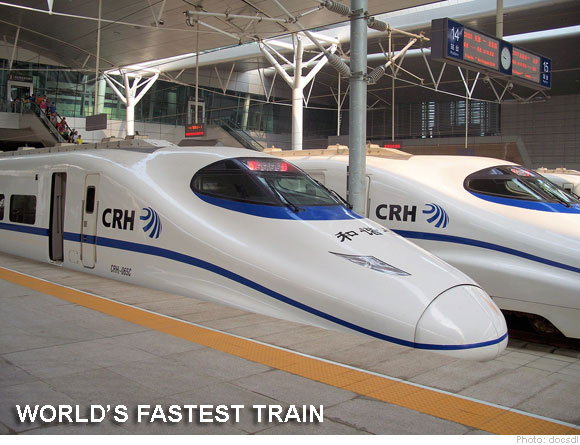China on Saturday launched what it described as the world’s fastest super high-speed train. The new bullet train runs at an average speed of 217 miles-an-hour, and can reach up to 245 miles-an-hour, cutting the 1,068 kilometers (664 miles) journey time between Wuhan in central China and Guangzhou in the country’s south (a business hub near Hong Kong) from the original 9 hours to about 3 hours.
The high speed line, which uses technology developed in co-operation with foreign firms such as Siemens, Bombardier and Alstom, is expected to act as a catalyst in the development of central China.
Chinese railway authorities said the average speed of the high-speed railways is 243 km per hour in Japan, 232 km per hour in Germany and 277 km per hour in France. China’ Harmony Express reached a maximum speed of 394.2 km per hour during trail runs that begun on December 9.
The Wuhan-Guangzhou railway is China’s fastest and longest high-speed railway. It has taken almost $15 billion and four years of construction to complete it, according to China’s official news agency Xinhua.
Meanwhile, here in the U.S. high-speed rail advocates have long dreamed of the day when bullet trains, just like in China, would revolutionize transportation. They in fact, have been pushing high-speed rail for 25 years and always fallen short. It is a shame we are so far behind. The Japanese have had “Shinkansen” bullet trains since the mid 1960s. France launched Europe’s first high-speed railroad between Paris and Lyon in 1981, the Train à Grande Vitesse. Israel has a new Tel Aviv-to-Jerusalem line in the works, and Saudi Arabia recently let contracts for a European-style supertrain between the western port of Jeddah and the religious centers of Mecca and Medina. What about America? Well, we can always find comfort in the fact that Amtrak will probably still be in operation 150 years from now.
Click for China’s bullet-train photos!
1 of 12 « »
- Bulenox: Get 45% to 91% OFF ... Use Discount Code: UNO
- Risk Our Money Not Yours | Get 50% to 90% OFF ... Use Discount Code: MMBVBKSM
Disclaimer: This page contains affiliate links. If you choose to make a purchase after clicking a link, we may receive a commission at no additional cost to you. Thank you for your support!



So far:
All CRH2s with has the label which ended with character “C”(such as CRH2-061C) and all CRH3s are desined for speed range of 300~350km/h.
All other CRHs are desiged for speed range of 200~250km/h.
Actually, all the CRHs are not really suitable for continual 350km/h operation because the operating cost is high.
The trains of next generation will be real 350km/h-operating trains. They are CRH2-350 and CRH3-350. They may come out in next 1 or 2 years and they will become the standard long-distance 350km/h trains.
I had the pleasure of testing out the Shanghai Meglev train as well as the Beijing Tianjin supertrain last May. Both were fantastic experiences. Their rides were smooth as glass and one does not feel much acceleration between leaving the station and reaching top speed, 400 kph for the Meglev and 325kph for the supertrain. The only sense of speed was the airplane like swoosh from outside the "fuselage.". The Meglev however has a regular up and down 50 Hz hum(son checked it on an online spectrum analyzer using the video-audio recording from his camera.) The seats were more comfortable than airplane seats and there was plenty of elbow room and leg room. Tickets could be purchased from touch screen kiosks at the station. It prints out a ticket complete with the coach and seat number. As such there was no overcrowding or misunderstandings about seat location. There were uniformed cleaning staff to pick up little while the train was in motion. A beautiful stewardess in a long smart uniform coat and cap (10 deg C weather then) would walk up and down the coaches solicitously asking us about our comfort. With someone pretty like that I can't see anyone resorting to rowdy behavior over anything. These supertrains will link China's major cities over the next ten years. There are also plans proposed for three such trains to go all the way to Europe, one to Singapore and the third to Taiwan via an undersea tunnel.
Its great if common Chinese people are able use modern, high
speed rail travel. Unfortunately 600,000 Chinese factory
workers commit suicide per year from despair because of their
gruelling work schedules, low pay and living conditions.
America is not a slave nation just yet, where 90% of incomes
are confiscated in taxes. It would be interesting to be able
to ask an average Chinese, who works 18 hour days, if he or
she would rather ride a 200 mph train or have higher wages
and shorter hours with less of their production taken by
government. Too bad the Chinese people are given no choice.
Perhaps if the U.S. stopped being the Policemen of the World,
spending trillions on useless and illegal wars, we could
build a decent rail system too. High speed is too much to
hope for here. Adequate public transportation would be like
a miracle for Americans after what we’ve been used to.